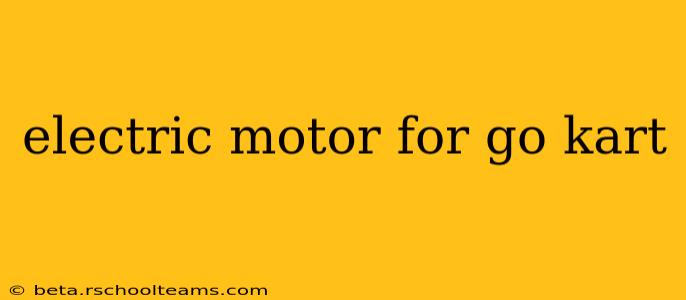Building or upgrading a go-kart with an electric motor offers a thrilling, eco-friendly alternative to gasoline engines. However, selecting the appropriate motor requires careful consideration of several factors. This guide will help you navigate the options and choose the perfect electric motor for your go-kart project.
What are the different types of electric motors for go-karts?
Several types of electric motors can power a go-kart, each with its advantages and disadvantages. The most common are brushed DC motors, brushless DC motors, and AC induction motors.
-
Brushed DC Motors: These are generally simpler and cheaper, making them a popular choice for beginners. However, they have shorter lifespans due to brush wear and are less efficient than brushless motors. They also tend to be less powerful for a given size.
-
Brushless DC Motors (BLDC): BLDC motors offer superior efficiency, longer lifespan (no brush wear), and higher power output compared to brushed DC motors. They're more complex and typically more expensive, but the performance gains are substantial, especially for more demanding go-kart applications.
-
AC Induction Motors: These motors are robust and can handle high torque, making them suitable for applications needing significant pulling power. They're typically used in more industrial settings and less common in go-kart builds due to their higher cost and complexity of control systems.
What size electric motor do I need for my go-kart?
The ideal motor size depends heavily on the go-kart's weight, desired speed, and terrain. A heavier go-kart or one intended for off-road use will require a more powerful motor. Consider these factors:
-
Go-kart Weight: Heavier go-karts need more powerful motors to accelerate and maintain speed.
-
Desired Top Speed: Higher top speeds necessitate motors with higher RPM and power ratings.
-
Terrain: Hilly or uneven terrain demands more torque, requiring motors with higher torque ratings.
How much power (kW or HP) do I need?
Power requirements are directly linked to the factors mentioned above. A small, lightweight go-kart might be adequately powered by a 1-2 kW motor, while a larger, heavier kart might need 5 kW or more. Remember that horsepower (HP) and kilowatts (kW) are interchangeable units of power; 1 kW is approximately 1.34 HP. Always check the motor's specifications to determine its power output under various load conditions.
What voltage battery do I need to run my chosen electric motor?
The motor's voltage requirements dictate the battery voltage you'll need. Common voltages include 24V, 36V, 48V, and 72V. Higher voltages generally mean higher power output but also necessitate more robust and potentially more expensive battery systems. The chosen voltage must match the motor's specification exactly or it could damage the motor.
What are the advantages and disadvantages of using an electric motor for a go-kart?
Advantages:
- Environmentally Friendly: Electric motors produce zero tailpipe emissions.
- Quieter Operation: Electric motors are significantly quieter than gasoline engines.
- Easier Maintenance: Electric motors require less maintenance than gasoline engines.
- Instant Torque: Electric motors provide instant torque, leading to quicker acceleration.
Disadvantages:
- Higher Initial Cost: The initial cost of an electric motor and battery system can be higher than a gasoline engine.
- Limited Range: The range of an electric go-kart is limited by the battery capacity.
- Charging Time: Charging the batteries takes time.
- Weight: Electric motors and batteries can add significant weight to the go-kart.
This guide provides a starting point for selecting the right electric motor for your go-kart. Remember to always consult the specifications of your chosen motor and battery system to ensure compatibility and safety. Proper planning and research are crucial for a successful electric go-kart build.
